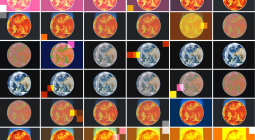‘He was choking on his own tongue’: animals suffer as heatwaves increase

Solly the sheep, who died at a Mallorcan animal sanctuary after contracting a mosquito-borne disease. Photograph: Ana Palacios
Solly the sheep had not had an easy start to life, but his prospects seemed to be looking up. Maggot-ridden when found in a field, Solly defied the expectations of a vet and recovered quickly when an animal shelter took him in. He befriended another sheep at the sanctuary, Star, and became a “leaping, happy lamb”, his rescuers said.
But Solly, named after the Spanish word for sun, could not cope with the scorching heat in Mallorca, Spain. He contracted a disease from mosquitoes, whose breeding window is widening. His frail body quickly declined.
“It was 40C on the day that he died, and he was choking on his own tongue,” said Nicole Eden, who runs the Eden Sanctuary for abandoned animals on the Spanish island.
Flies soon swarmed the body. Unable to leave the other animals, who were also baking in the hot sun, Eden dug Solly a shallow grave with her hands and buried him through her tears.
“I couldn’t leave the body for even an hour,” said Eden, who had nursed the lamb to health. “I’m there crying over the loss of my baby and I don’t have time to consider my grief.”
Humans are not the only animals hurt by hot weather. From puppies whose paws toast on piping-hot pavements to koalas unable to outrun fast-spreading fires, the animal world is already suffering from a glut of greenhouse gas pollution that has made heatwaves hotter and longer.
In some ways, the situation in rescue shelters during hot weather mirrors that of hospitals around the world. Those who die first are often old, ill or young. Drought makes it harder to get hold of water. For facilities that are underfunded and rely on volunteers, efforts to keep cool cost money and time that are in short supply.
“It’s a constant worry that if we turn our backs for too long, the animals will end up with heatstroke,” said Eden, who lost a dog to the heat this year and suspects chickens and guinea pigs have also perished because of the hot weather. “It puts an immense amount of guilt on us.”
The most visible victims among animals are those that people keep as pets or raise for slaughter. But the damage reaches deep into the wild. The breakdown of a stable climate is one of five key drivers of the “unprecedented” and “accelerating” loss of wildlife around the world, according to a report from the Intergovernmental Science-Policy Platform on Biodiversity and Ecosystem Services, the leading scientific authority on biodiversity.
Ben Church, a firefighter in Western Australia, said that seeing dead and burned creatures when battling bushfires was a harsh reality of the job. He has found the bodies of animals as big as kangaroos and emus among the ashes.
“You can’t see too much at night, but in the day you see the level of devastation,” he said. “There’s nothing living. It’s a barren wasteland.”
Nearly 3 billion animals were killed or displaced by Australia’s devastating bushfire season of 2019-20, according to a report from scientists commissioned by WWF Australia. In a separate study of marsupials – kangaroos, koalas, wallabies and possums – researchers found that rescue and rehabilitation rates were lower than expected.
Scientists say saving human and other animal lives means pumping out less planet-heating gas and adapting to violent weather.
Church, who has posed topless with animals for the Australian firefighters calendar, which has raised money to buy a mobile facility for Byron Bay wildlife hospital, said part of the solution was getting people to care more about the damage that humans are doing to animal habitats.
“They feel the same anguish and pain that people do when they lose their homes,” said Church. “They’re experiencing that heat just like we are.”
But the empathy gap is harder to bridge for some animals than others. When Hugo Harrison first became a marine scientist, he was drawn by the prospect of exploring a “magical underwater world”. He began to work on corals, which are made up of vast numbers of individual animals called polyps. Heatwaves are bleaching their colourful reefs skeleton white.
“I have seen a world beyond my wildest imagination as a child,” said Harrison, who at the University of Bristol studies how corals recover after heatwaves. “And I think the most striking experience that I’ve had recently is seeing these environments silenced.”
He compared diving in a coral reef after a marine heatwave to walking in a tropical forest after a fire: “It’s like diving in a ghost city.”
The Intergovernmental Panel on Climate Change found that 70%-90% of tropical corals would be killed by a global temperature rise of 1.5C (2.7F), and “virtually all” of them will be lost at 2C. The world is on track to hit 2.5C by the end of the century, despite world leaders promising to keep it “well below” 2C.
Harrison said it was “paralysing” to imagine that future. But even with such losses already under way, he added, corals are not yet doomed. “What gives me hope is that as long as we can keep things mild, as long as things don’t get so severe that corals cook on the spot, then there is a pathway that allows them to adapt to these events.”
At the animal sanctuary in Mallorca, Eden has asked a couple to take over the day-to-day management of the shelter but continues to fundraise for it. Running out of options to survive the heat, she said she had considered moving the animals to the north of the Spanish mainland, where the climate is cooler.
Summer is by far the most stressful period, said Eden, who was diagnosed with post-traumatic stress disorder after the summer in which Solly and a few other animals died. “That sequence of memories I have from digging Solly’s grave, that’s one of the recurring images I get … At points it’s felt like a nightmare.”





